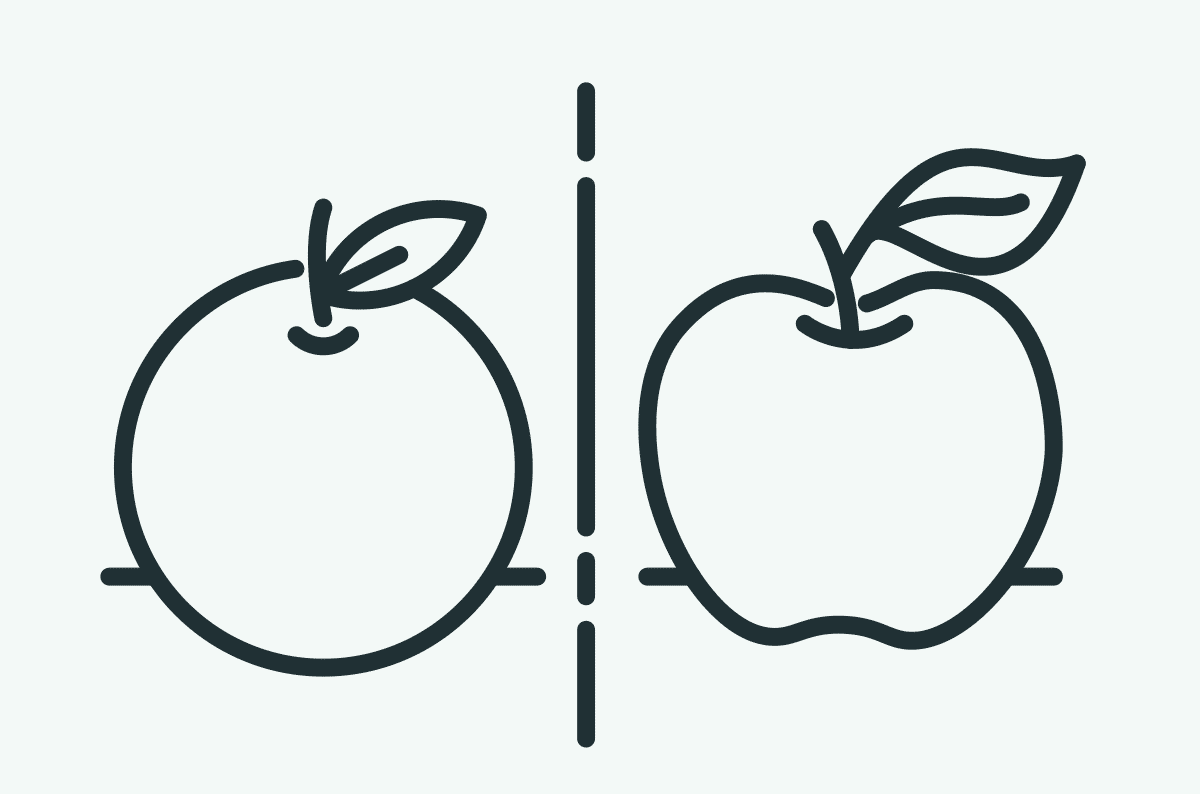|
Listen to post:
Getting your Trinity Audio player ready...
|
There is a common cliché that is often thrown around during SASE vendor discussions “you are comparing apples to oranges.” This phrase is typically used when looking at functions or features of a product, but often is used by people looking to discredit a solution offered by a competitor. It is natural, however, as every single vendor is inherently biased to believe that their offering is the best. So, let us take a look at what this expression means, and why we should compare apples and oranges when evaluating SASE solutions.
Why Compare Apples and Oranges
An apple and an orange have many things in common. They are both fruits, they are both round, they both can taste sweet (or sour), and both can do damage if they are thrown in anger. Based on these characteristics alone, there is no discernible difference between the two.
Now, what are the differences? The question you need to ask yourself is, “What do I want?” If you are looking to make an apple pie, then the choice is obvious. However, if your goal is to just eat something fruity, then that is where the deliberation begins. Do you buy an apple? Do you buy an orange? If you do not have an idea in mind, it is easy to get overwhelmed in the fruit aisle…
Mapping Architecture to Your End Goal
Look at the solutions and technologies that you use today within your corporate network and think about the purpose of their design. Have you purchased an orange or an apple, or do you have a chaotic digital fruit-salad which has grown organically over time due to a myriad of tastes and preferences? If so, you need to re-evaluate your entire corporate strategy to help you grow and develop into the future.
The architecture of every fruit has a purpose and has been designed in an optimal way to ensure continuity of their lineage. The orange has segments which may hold individual seeds, while grapes grow in a bunch connected by the stalks. This his could be compared to a microservice architecture, such as Docker (packing containerized applications on a single node) or Kubernetes (running containerized applications across a cluster). Each fruit has its pros, cons, and uses, however the more fruit you want, the more difficult your life becomes. You need to understand the architecture of each fruit, and then go on to identify the best-practice for fruit combinations. You need to know the purpose and intent of each piece of fruit, and you need to locate a myriad of different fruits. This is manageable if there’s only one person purchasing and eating fruit for the company, but as soon as you add another personality – the situation evolves, in a negative way, and we haven’t even thought of the fruit bowl challenge.
SASE RFI/RFP Made Easy | Get the TemplateThe Fruit Bowl Challenge
Every time you purchase a piece of fruit, you need to store it somewhere. This could be in the fridge, in a bowl, in a cupboard, or left in your car under the scorching sun. To purchase each piece of fruit, you may need to go to different shops, with varying levels of quality. Should you purchase a Jazz Apple or a Braeburn, a Clementine or a Satsuma? Once you’ve identified which specific type of fruit you want, where can you get it at the right price? Shop A may offer it at a lower price than Shop B today, but that’s a limited time offer. When you’re trying to maximise a constrained budget, the time investment required to ensure you purchase something of quality and longevity can be a moderately significant effort.
Now, consider each piece of fruit is a component of your network. You want to purchase edge security, so you gather several vendors to check for bruises, blemishes, and pack-size. After making your decision on what to buy (after months of deliberation, RFPs, and proof-of-concepts), you then move to the negotiation stage with hundreds of distributors, resellers, or VARs. Finally, you close on the deal, and they send you a truck full of apples. It’s what you wanted right? I hope you have somewhere to store all those apples, because the clock is ticking, and they’re already starting to spoil.
Turning Apples into Apple Pie
So, you have your apples, you can see them, and you proudly gaze upon the mountain of fruit sat in your warehouse. You’ve spent a lot of money on these apples, and you’ve cashed in all your favours with your CFO to get the budget approved for this gargantuan upfront cost. Now the real work begins, as you need to prepare for the implementation, deployment, and creation of your apple pies (or firewall/site deployments, I’m sticking to the metaphor here!)
The first thing you do is hire a group of people to move the apples into neat piles. Then you hire another group of people to come and peel the apples, as well as a disposal company to remove the packaging/peel that you no longer need. Once fully peeled and sliced, you then need a way to transport the prepared goods to the next location for processing – all of this is required even before your apples touch pastry. However, you accounted for this during your initial budget spend, and do not see it as a concern, until you notice that some of the fruit has already turned rotten. You need to contact the vendor to initiate a return (RMA), and this is where you notice problems.
The Rotten Apple Problem
“Your support contract on this apple has expired.”
I personally used to work for an appliance (fruit) based company, and I had to tell customers this on an almost daily basis. People call Support for assistance as their sites may be down, or critical applications have been impacted by service outages and they need urgent P1 Support. However, if the customer had not actively maintained their Support contracts, then there is no legal obligation to assist resolve their problem. In fact, if the vendor operates on a ‘Support & Maintenance per device’ basis, it’s within their interest to actively withhold assistance until you pay the money to reinstate the contract.
How many apples did you just buy? Did you take a Support contract out on every apple? Are you actively tracking the start and end-date of the renewal? Have you invested in administrative staff to ensure you have consistency of care? Will this vendor assist you with bruised apples, or does your contract only cover total losses? These are questions you should be asking yourself as you review the entire total cost of ownership for every single purchased asset. If you’ve amortized an apple over a 5-year period, do you think you’ll still be wanting the same apple 5 years from now? Your taste may have changed.
Oh, and did you remember, currently you haven’t just purchased apples for your company. Life isn’t that simple. You’ve also purchased your grapes, peaches, plums, pears, bananas and more, because you want to maintain in complete control of your network using point products. How does this make you feel having to constantly maintain this supply chain? Your life has become confusing, and this all started because somebody originally said that you were ‘comparing apples to oranges.’
The Cato Solution
We’ve been talking in metaphors during this article, but let’s drop the pretence and start talking directly. Today your network is most likely built with a series of different products built by a myriad of vendors. You have network firewalls, internet gateways, CASB engines, VPN concentrators, anti-malware engines, Intrusion Prevention Systems (IPS) and many more. Each of these products have been built by their vendors in the belief that they are the best in their own functional field, however to you as a consumer of products, you have a wide portfolio of products that you must learn (as well as maintain, update, and manage.) Dealing with these administrative tasks are likely not the reason you decided to get into IT, but here you are. Life doesn’t have to be this way.
Cato Networks offers a truly converged service offering covering all aspects of Networking, Security and Access. The term ‘service offering’ is key, as we maintain, manage, and continually improve our service in the cloud, ensuring that you have the latest-and-greatest in networking and security coverage without having to lift a finger. Unlike product-based companies, you don’t have to have significant warehouse space to store hundreds of servers and appliances, you don’t need to worry about multitudes of service contracts, and best of all, you don’t need to worry about upgrading or patching (as this is done by Cato Networks.)
How to Solve the Fruit Bowl Challenge with Cato
So, in short, apples are great, and oranges are fine. But why limit yourself? What if I told you that you could have BOTH apples and oranges? What if I told you that you could get both using a single service subscription? What if I told you that we’re constantly growing our catalogue of SASE features and offerings, so you also get peaches, plums, pineapples, and pears at no extra cost? What if I told you that new fruit is being added every two weeks? Why limit yourself to just buying apples, when Cato can offer you every fruit under the sun, whenever you want it, all at the click of a button.










